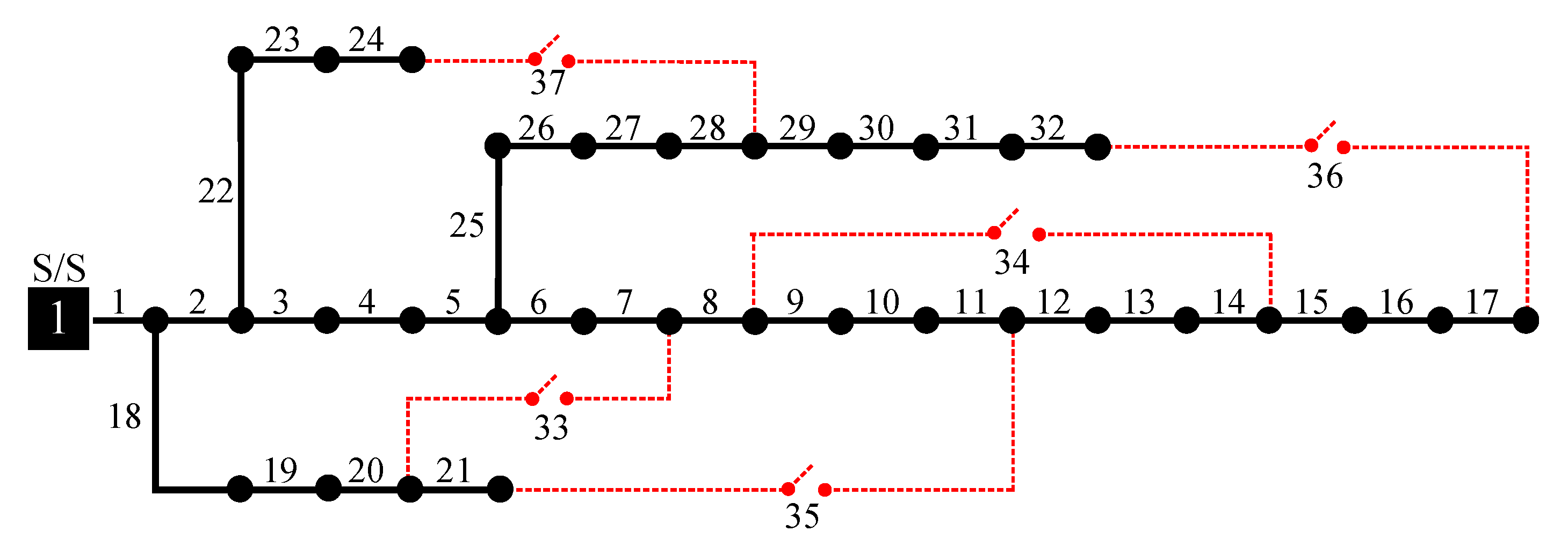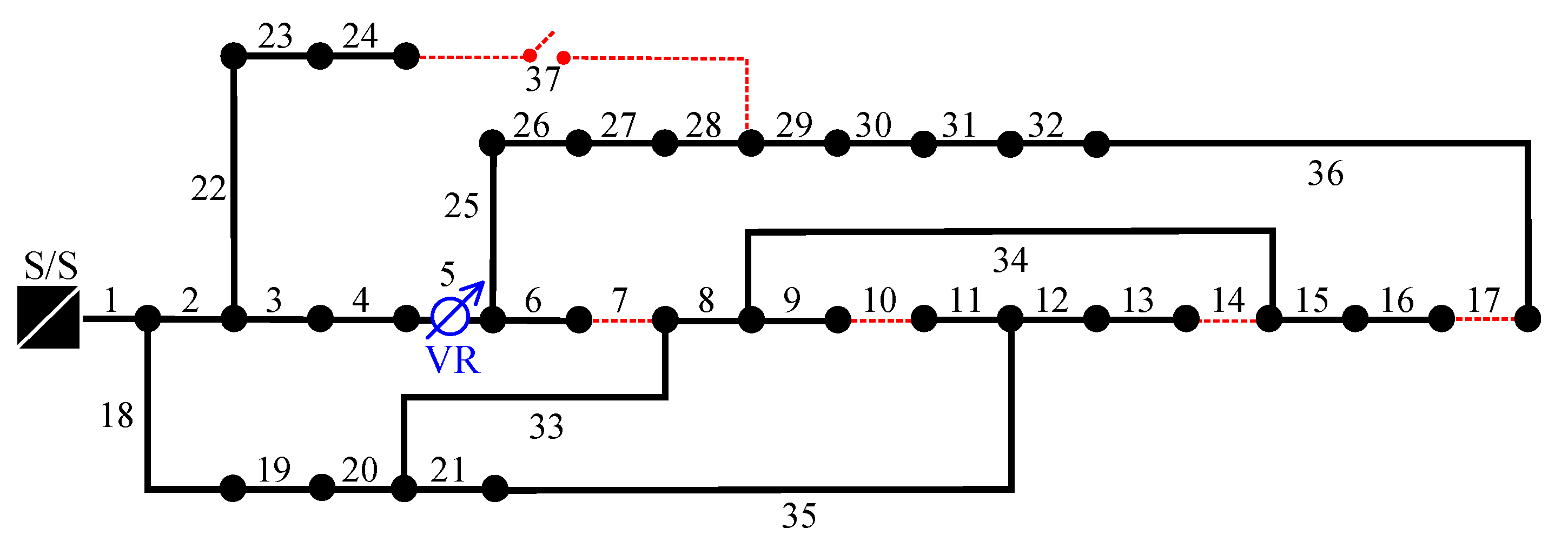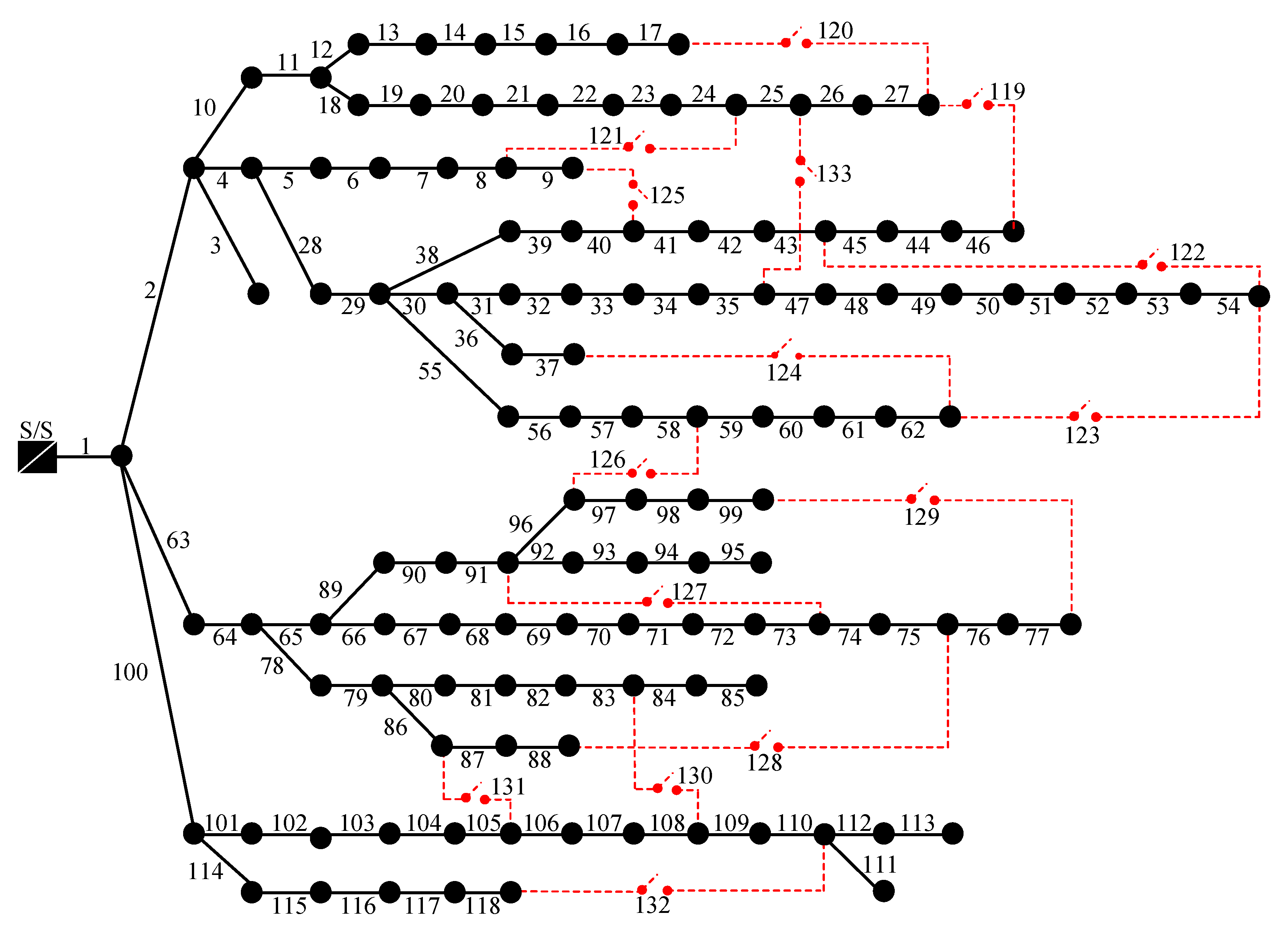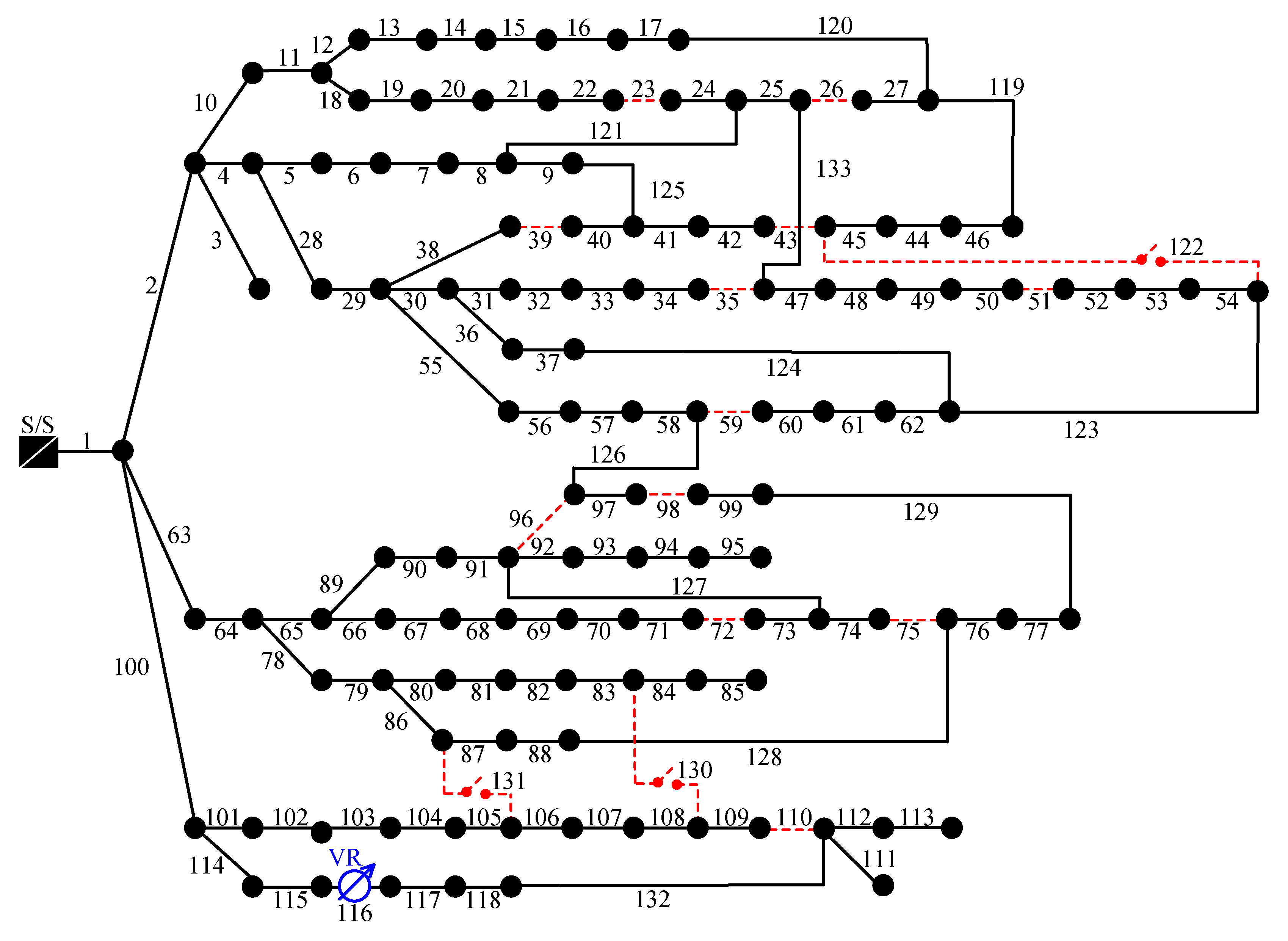Optimal Feeder Reconfiguration and Placement of Voltage Regulators in Electrical Distribution Networks Using a Linear Mathematical Model
Abstract
:1. Introduction
2. Mathematical Model
2.1. Nonlinear Power Flow for Radial Distribution Networks
2.2. Objective Function
2.3. Constraints Related to the OPVRs and DNR
2.4. Linearization of the Mathematical Model
2.5. MILP Model for Optimal DNR and OPVR
3. Results
- -
- Case I: Initial Base case.
- -
- Case II: Only DNR.
- -
- Case III: Only OPVRs.
- -
- Case IV: Simultaneous DNR and OPVRs.
- The interest rate of the cost of active power losses () is assumed to be 168 USD/kW-year [45].
- The cost of installation of each VR () is 10,000 USD/line independently of its location in the distribution system [41].
- The maximum number of VR () is equal to 3 but can be set to any other limit.
- To guarantee the quality of service supply, distribution network operators must maintain voltages within certain ranges. Admissible voltage magnitudes are between 0.90 to 1.05 p.u.
- As the problem is approached from the distribution planning standpoint, the degradation of VRs due to commutation is neglected.
3.1. Results of the 33-Bus Test System
3.2. Results of the 69-Bus Test System
3.3. Results of the 119-Bus Test System
4. Comparative Analysis of Results
4.1. Comparison with Other Research Works
4.2. Effect of DG in the Proposed Model
5. Conclusions
Author Contributions
Funding
Institutional Review Board Statement
Informed Consent Statement
Data Availability Statement
Acknowledgments
Conflicts of Interest
References
- Rullo, P.G.; Braccia, L.; Feroldi, D.; Zumoffen, D. Multivariable Control Structure Design for Voltage Regulation in Active Distribution Networks. IEEE Lat. Am. Trans. 2022, 20, 839–847. [Google Scholar] [CrossRef]
- Razavi, S.M.; Momeni, H.R.; Haghifam, M.R.; Bolouki, S. Multi-Objective Optimization of Distribution Networks via Daily Reconfiguration. IEEE Trans. Power Deliv. 2022, 37, 775–785. [Google Scholar] [CrossRef]
- Gallego Pareja, L.A.; López-Lezama, J.M.; Gómez Carmona, O. A Mixed-Integer Linear Programming Model for the Simultaneous Optimal Distribution Network Reconfiguration and Optimal Placement of Distributed Generation. Energies 2022, 15, 3063. [Google Scholar] [CrossRef]
- López-Lezama, J.M.; Cortina-Gómez, J.; Munoz, N. Assessment of the Electric Grid Interdiction Problem using a nonlinear modeling approach. Electr. Power Syst. Res. 2017, 144, 243–254. [Google Scholar] [CrossRef]
- Montoya, O.D.; Grisales-Noreña, L.F.; Perea-Moreno, A.J. Optimal Investments in PV Sources for Grid-Connected Distribution Networks: An Application of the Discrete-Continuous Genetic Algorithm. Sustainability 2021, 13, 13633. [Google Scholar] [CrossRef]
- Jaramillo Serna, J.d.J.; López-Lezama, J.M. Alternative Methodology to Calculate the Directional Characteristic Settings of Directional Overcurrent Relays in Transmission and Distribution Networks. Energies 2019, 12, 3779. [Google Scholar] [CrossRef] [Green Version]
- Li, Y.; Hao, G.; Liu, Y.; Yu, Y.; Ni, Z.; Zhao, Y. Many-Objective Distribution Network Reconfiguration Via Deep Reinforcement Learning Assisted Optimization Algorithm. IEEE Trans. Power Deliv. 2022, 37, 2230–2244. [Google Scholar] [CrossRef]
- Saldarriaga-Zuluaga, S.D.; López-Lezama, J.M.; Muñoz-Galeano, N. Adaptive protection coordination scheme in microgrids using directional over-current relays with non-standard characteristics. Heliyon 2021, 7, e06665. [Google Scholar] [CrossRef]
- Montoya, O.D.; Gil-González, W.; Grisales-Noreña, L.F. Solar Photovoltaic Integration in Monopolar DC Networks via the GNDO Algorithm. Algorithms 2022, 15, 277. [Google Scholar] [CrossRef]
- Agudelo, L.; López-Lezama, J.M.; Muñoz-Galeano, N. Vulnerability assessment of power systems to intentional attacks using a specialized genetic algorithm. Dyna 2015, 82, 78–84. [Google Scholar] [CrossRef]
- Eldurssi, A.M.; O’Connell, R.M. A Fast Nondominated Sorting Guided Genetic Algorithm for Multi-Objective Power Distribution System Reconfiguration Problem. IEEE Trans. Power Syst. 2015, 30, 593–601. [Google Scholar] [CrossRef]
- Zhang, J.; Yuan, X.; Yuan, Y. A novel genetic algorithm based on all spanning trees of undirected graph for distribution network reconfiguration. J. Mod. Power Syst. Clean Energy 2014, 2, 143–149. [Google Scholar] [CrossRef] [Green Version]
- Srinivasa Rao, R.; Narasimham, S.V.L.; Ramalinga Raju, M.; Srinivasa Rao, A. Optimal Network Reconfiguration of Large-Scale Distribution System Using Harmony Search Algorithm. IEEE Trans. Power Syst. 2011, 26, 1080–1088. [Google Scholar] [CrossRef]
- dos Santos, M.V.; Brigatto, G.A.; Garcés, L.P. Methodology of solution for the distribution network reconfiguration problem based on improved harmony search algorithm. IET Gener. Transm. Distrib. 2020, 14, 6526–6533. [Google Scholar] [CrossRef]
- Dias Santos, J.; Marques, F.; Garcés Negrete, L.P.; Andrêa Brigatto, G.A.; López-Lezama, J.M.; Muñoz-Galeano, N. A Novel Solution Method for the Distribution Network Reconfiguration Problem Based on a Search Mechanism Enhancement of the Improved Harmony Search Algorithm. Energies 2022, 15, 2083. [Google Scholar] [CrossRef]
- Shetty, V.J.; Ankaliki, S.G. Electrical Distribution System Power Loss Reduction and Voltage Profile Enhancement by Network Reconfiguration Using PSO. In Proceedings of the 2019 Fifth International Conference on Electrical Energy Systems (ICEES), Chennai, India, 21–22 February 2019; pp. 1–4. [Google Scholar] [CrossRef]
- Kumar, B.; Saw, B.K.; Bohre, A.K. Optimal Distribution Network Reconfiguration to Improve the System Performances using PSO with Multiple-Objectives. In Proceedings of the 2020 International Conference on Computational Intelligence for Smart Power System and Sustainable Energy (CISPSSE), Keonjhar, India, 29–31 July 2020; pp. 1–6. [Google Scholar] [CrossRef]
- Pegado, R.; Ñaupari, Z.; Molina, Y.; Castillo Correa, C. Radial distribution network reconfiguration for power losses reduction based on improved selective BPSO. Electr. Power Syst. Res. 2019, 169, 206–213. [Google Scholar] [CrossRef]
- Mahdavi, M.; Alhelou, H.H.; Bagheri, A.; Djokic, S.Z.; Ramos, R.A.V. A Comprehensive Review of Metaheuristic Methods for the Reconfiguration of Electric Power Distribution Systems and Comparison With a Novel Approach Based on Efficient Genetic Algorithm. IEEE Access 2021, 9, 122872–122906. [Google Scholar] [CrossRef]
- Safigianni, A.; Salis, G. Optimum voltage regulator placement in a radial power distribution network. Power Syst. IEEE Trans. 2000, 15, 879–886. [Google Scholar] [CrossRef]
- Rao, J.; Sivanagaraju, S. Voltage Regulator Placement in Radial Distribution System Using Discrete Particle Swarm Optimization. Int. Rev. Electr. Eng. 2008, 3, 525–531. [Google Scholar]
- Ganesh Vulasala, S.n.S.; Thiruveedula, R. Genetic algorithm based voltage regulator placement in unbalanced radial distribution systems. Acta Electroteh. 2009, 50, 253–259. [Google Scholar]
- Pereira, C.; Castro, C. Optimal placement of voltage regulators in distribution systems. In Proceedings of the 2009 IEEE Bucharest PowerTech, Bucharest, Romania, 28 June–2 July 2009; pp. 1–5. [Google Scholar] [CrossRef]
- Visali. Nagalamadaka, S.S.; Sankar, V. Loss Reduction in Radial Distribution Systems by Optimal Voltage Regulator Placement Using Fuzzy Logic. Int. J. Electr. Eng. 2010, 3, 147–160. [Google Scholar]
- Rao, P.R.; Raju, S.S. Voltage regulator placement in radial distribution system using plant growth simulation algorithm. Int. J. Eng. Sci. Technol. 2010, 2, 207–217. [Google Scholar] [CrossRef] [Green Version]
- Mendoza Baeza, J.; Peña, H. Automatic voltage regulators siting in distribution systems considering hourly demand. Lancet 2011, 81, 1124–1131. [Google Scholar] [CrossRef]
- Manikandan, S.; Sasitharan, S.; Rao, J.V. Analysis of Optimal AVR Placement in Radial Distribution Systems using Discrete Particle Swarm Optimization. Innov. Syst. Des. Eng. 2012, 3, 27–42. [Google Scholar]
- Salkuti Surender Reddy, L.Y.H. Optimum location of voltage regulators in the radial distribution systems. Int. J. Emerg. Electr. Power Syst. 2016, 17, 351–361. [Google Scholar] [CrossRef]
- Pimentel Filho, M.C.; Medeiros, M. Localization of voltage regulators in distribution systems by a mixed Genetic–Tabu search algorithm. Energy Power Eng. 2013, 5, 751–755. [Google Scholar] [CrossRef]
- Attar, M.; Homaee, O.; Falaghi, H.; Siano, P. A novel strategy for optimal placement of locally controlled voltage regulators in traditional distribution systems. Int. J. Electr. Power Energy Syst. 2018, 96, 11–22. [Google Scholar] [CrossRef]
- Muthukumar, K.; Jayalalitha, S.; Sureshkumar, K.; Sakthivel, A. Artificial Bee Colony Algorithm Based Placement and Optimal Tap Selection of Voltage Regulators for Power Loss Minimization in Distribution System. Int. J. Pure Appl. Math. 2018, 118, 2295–2313. [Google Scholar]
- Molla Addisu, A.O.S.; Takele, H. Fuzzy logic based optimal placement of voltage regulators and capacitors for distribution systems efficiency improvement. Heliyon 2021, 7, e07848. [Google Scholar] [CrossRef]
- Shaheen, A.M.; El-Sehiemy, R.A. Optimal Coordinated Allocation of Distributed Generation Units/ Capacitor Banks/ Voltage Regulators by EGWA. IEEE Syst. J. 2021, 15, 257–264. [Google Scholar] [CrossRef]
- Gallego, L.A.; López-Lezama, J.M.; Gómez, O. Optimal Placement of Capacitors, Voltage Regulators, and Distributed Generators in Electric Power Distribution Systems. Ingeniería 2020, 25, 334–354. [Google Scholar] [CrossRef]
- Zhou, A.; Zhai, H.; Yang, M.; Lin, Y. Three-Phase Unbalanced Distribution Network Dynamic Reconfiguration: A Distributionally Robust Approach. IEEE Trans. Smart Grid 2022, 13, 2063–2074. [Google Scholar] [CrossRef]
- Navesi, R.B.; Nazarpour, D.; Ghanizadeh, R.; Alemi, P. Switchable Capacitor Bank Coordination and Dynamic Network Reconfiguration for Improving Operation of Distribution Network Integrated with Renewable Energy Resources. J. Mod. Power Syst. Clean Energy 2022, 10, 637–646. [Google Scholar] [CrossRef]
- Franco, J.F.; Rider, M.J.; Lavorato, M.; Romero, R. A mixed-integer LP model for the optimal allocation of voltage regulators and capacitors in radial distribution systems. Int. J. Electr. Power Energy Syst. 2013, 48, 123–130. [Google Scholar] [CrossRef]
- Gallego, L.A.; Franco, J.F.; Cordero, L.G. A fast-specialized point estimate method for the probabilistic optimal power flow in distribution systems with renewable distributed generation. Int. J. Electr. Power Energy Syst. 2021, 131, 107049. [Google Scholar] [CrossRef]
- Cespedes, R.G. New method for the analysis of distribution networks. IEEE Trans. Power Deliv. 1990, 5, 391–396. [Google Scholar] [CrossRef]
- Gallego, L.A.; López-Lezama, J.M.; Carmona, O.G. A Mixed-Integer Linear Programming Model for Simultaneous Optimal Reconfiguration and Optimal Placement of Capacitor Banks in Distribution Networks. IEEE Access 2022, 10, 52655–52673. [Google Scholar] [CrossRef]
- Franco, J.; Lavorato, M.; Rider, M.J.; Romero, R. An efficient implementation of tabu search in feeder reconfiguration of distribution systems. In Proceedings of the 2012 IEEE Power and Energy Society General Meeting, San Diego, CA, USA, 22–26 July 2012; pp. 1–8. [Google Scholar] [CrossRef]
- Olszak, A.; Karbowski, A. Parampl: A Simple Tool for Parallel and Distributed Execution of AMPL Programs. IEEE Access 2018, 6, 49282–49291. [Google Scholar] [CrossRef]
- Gay, D.M. The AMPL Modeling Language: An Aid to Formulating and Solving Optimization Problems. Numer. Anal. Optim. 2015, 134, 95–116. [Google Scholar] [CrossRef] [Green Version]
- Gallego, L.A.; López-Lezama, J.M.; Gómez, O. Data of the Electrical Distribution Systems for the Optimal Reconfiguration Used in This Paper. 2022. Available online: https://github.com/LuisGallego2019/ElectricalSystemsDataForReconfiguration (accessed on 15 October 2022).
- Ramesh Babu, M.; Kumar, C.; Anitha, S. Simultaneous Reconfiguration and Optimal Capacitor Placement Using Adaptive Whale Optimization Algorithm for Radial Distribution System. J. Electr. Eng. Technol. 2020, 16, 181–190. [Google Scholar] [CrossRef]
- Gnanasekaran, N.; Chandramohan, S.; Kumar, P.S.; Mohamed Imran, A. Optimal placement of capacitors in radial distribution system using shark smell optimization algorithm. Ain Shams Eng. J. 2016, 7, 907–916. [Google Scholar] [CrossRef]
- Salimon, S.; Suuti, K.; Adeleke, H.; Ebenezer, O.K.; Aderinko, H. Impact of Optimal Placement and Sizing of Capacitors on Radial Distribution Network using Cuckoo Search Algorithm. Curr. J. Appl. Sci. Technol. 2020, 15, 39–49. [Google Scholar] [CrossRef]
- Lavorato, M.; Franco, J.F.; Rider, M.J.; Romero, R. Imposing Radiality Constraints in Distribution System Optimization Problems. IEEE Trans. Power Syst. 2012, 27, 172–180. [Google Scholar] [CrossRef]
- Abdelaziz, A.; Mohamed, F.; Mekhamer, S.; Badr, M. Distribution system reconfiguration using a modified Tabu Search algorithm. Electr. Power Syst. Res. 2010, 80, 943–953. [Google Scholar] [CrossRef]
- Hijazi, H.; Thiébaux, S. Optimal distribution systems reconfiguration for radial and meshed grids. Int. J. Electr. Power Energy Syst. 2015, 72, 136–143. [Google Scholar] [CrossRef]
- Mahdavi, M.; Alhelou, H.H.; Hatziargyriou, N.D.; Al-Hinai, A. An Efficient Mathematical Model for Distribution System Reconfiguration Using AMPL. IEEE Access 2021, 9, 79961–79993. [Google Scholar] [CrossRef]
- Taylor, J.A.; Hover, F.S. Convex Models of Distribution System Reconfiguration. IEEE Trans. Power Syst. 2012, 27, 1407–1413. [Google Scholar] [CrossRef]
- Khorshid-Ghazani, B.; Seyedi, H.; Mohammadi-ivatloo, B.; Zare, K.; Shargh, S. Reconfiguration of distribution networks considering coordination of the protective devices. IET Gener. Transm. Distrib. 2017, 11, 82–92. [Google Scholar] [CrossRef]
- Abdelaziz, A.; Mohammed, F.; Mekhamer, S.; Badr, M. Distribution Systems Reconfiguration using a modified particle swarm optimization algorithm. Electr. Power Syst. Res. 2009, 79, 1521–1530. [Google Scholar] [CrossRef]
- Quadri, I.; Bhowmick, S. A hybrid technique for simultaneous network reconfiguration and optimal placement of distributed generation resources. Soft Comput. 2020, 24. [Google Scholar] [CrossRef]
- Siahbalaee, J.; Rezanejad, N.; Gharehpetian, G.B. Reconfiguration and DG Sizing and Placement Using Improved Shuffled Frog Leaping Algorithm. Electr. Power Components Syst. 2019, 47, 1475–1488. [Google Scholar] [CrossRef]
- Ben Hamida, I.; Salah, S.; Faouzi, M.; Mimouni, M. Optimal integration of distributed generations with network reconfiguration using a Pareto algorithm. Int. J. Renew. Energy Res. 2018, 8, 345–356. [Google Scholar]
- Chen, Q.; Wang, W.; Wang, H.; Wu, J.; Wang, J. An Improved Beetle Swarm Algorithm Based on Social Learning for a Game Model of Multiobjective Distribution Network Reconfiguration. IEEE Access 2020, 8, 200932–200952. [Google Scholar] [CrossRef]
- Wang, C.; Lei, S.; Ju, P.; Chen, C.; Peng, C.; Hou, Y. MDP-Based Distribution Network Reconfiguration With Renewable Distributed Generation: Approximate Dynamic Programming Approach. IEEE Trans. Smart Grid 2020, 11, 3620–3631. [Google Scholar] [CrossRef]
- Shojaei, F.; Rastegar, M.; Dabbaghjamanesh, M. Simultaneous placement of tie-lines and distributed generations to optimize distribution system post-outage operations and minimize energy losses. CSEE J. Power Energy Syst. 2021, 7, 318–328. [Google Scholar] [CrossRef]










| Case | Open | Total Cost | VRs Cost | Losses Cost | Voltage Regulator | Power Losses | Vmin | Time | |
|---|---|---|---|---|---|---|---|---|---|
| Switches | USD | USD | USD | Taps | Branch | (kW) | (p.u) | (s) | |
| I | 33 to 37 | 34,048 | – | 34,048 | – | – | 202.67 | 0.9131 | – |
| II | 7, 9, 14, 32, 37 | 23,744 | – | 23,444 | – | – | 139.55 | 0.9378 | 0.46 |
| III | 33 to 37 | 43,035 | 10,000 | 33,035 | +8 | 6 | 196.64 | 0.9635 | 0.26 |
| IV | 7, 10, 14, 17, 37 | 36,550 | 10,000 | 26,550 | +5 | 6 | 158.04 | 0.9606 | 25.18 |
| Case | Open | Total Cost | VRs Cost | Losses Cost | Voltage Regulator | Power Losses | Vmin | Time | |
|---|---|---|---|---|---|---|---|---|---|
| Switches | USD | USD | USD | Taps | Branch | (kW) | (p.u) | (s) | |
| I | 69 to 73 | 37,798 | – | 37,798 | – | – | 224.99 | 0.9092 | – |
| II | 14, 55, 61, 69, 70 | 16,734 | – | 16,734 | – | – | 99.61 | 0.9427 | 2.42 |
| III | 69 to 73 | 46,120 | 10,000 | 36,120 | +7 | 57 | 215.01 | 0.9564 | 0.38 |
| IV | 10, 13, 20, 56, 61 | 28,179 | 10,000 | 18,179 | +1 | 49 | 108.18 | 0.9551 | 83.78 |
| Case | Open | Total Cost | VRs Cost | Losses Cost | Voltage Regulator | Power Losses | Vmin | Time | |
|---|---|---|---|---|---|---|---|---|---|
| Switches | USD | USD | USD | Taps | Branch | (kW) | (p.u) | (s) | |
| I | 119 to 133 | 217,823 | – | 217,823 | – | – | 1296.57 | 0.8687 | – |
| II | 24, 26, 35, 40, 43, 51, 59, 72, 75, 96, 98, 110, 122, 130, 131 | 143,401 | – | 143,401 | – | – | 853.58 | 0.9322 | 10.73 |
| III | 135 to 156 | 224,996 | 10,000 | 214,996 | +13 | 71 | 1279.74 | 0.9053 | 3.48 |
| IV | 23, 26, 35, 39, 43, 51, 59, 72, 75, 96, 98, 110, 122, 130, 131 | 156,931 | 10,000 | 146,931 | +7 | 121 | 874.59 | 0.9501 | 1,136.10 |
| Method | VR at Bus | Power Loss (%) | Voltage Regulation (%) |
|---|---|---|---|
| DPSO [21] | 4, 5 and 6 | 3.99 | 4.53 |
| DPSO [25,27] | 5 and 6 | 4.15 | 2.86 |
| PGSA [25,27] | 5 and 6 | 4.09 | 2.85 |
| MILP for OPVR | 6 | 5.29 | 3.65 |
| MILP for OPVR and DNR | 6 | 4.25 | 3.94 |
| Method | VR at Bus | Power Loss (%) | Voltage Regulation (%) |
|---|---|---|---|
| DPSO [21] | 57 and 60 | 4.10 | 4.42 |
| BT [24] | 57 | 5.33 | 4.35 |
| FL [24] | 6 and 57 | 5.23 | 2.94 |
| DPSO [25] | 58, 59 and 60 | 4.15 | 4.98 |
| PGSA [25] | 57 and 60 | 4.09 | 4.13 |
| BT [28] | 57 | 5.34 | 4.35 |
| MILP for OPVR | 57 | 5.65 | 4.36 |
| MILP for OPVR and DNR | 49 | 2.84 | 4.49 |
| Open | Total Cost | VRs Cost | Losses Cost | Voltage Regulator | Power Losses | Vmin | Time | |
|---|---|---|---|---|---|---|---|---|
| Switches | USD | USD | USD | Taps | Branch | (kW) | (p.u) | (s) |
| 23, 26, 35, 40, 43, 52, 59, 71, 74, 83, 96, 98, 110, 122, 131 | 146,481 | 10,000 | 136,481 | +1 | 117 | 812.39 | 0.9508 | 1294.10 |
Disclaimer/Publisher’s Note: The statements, opinions and data contained in all publications are solely those of the individual author(s) and contributor(s) and not of MDPI and/or the editor(s). MDPI and/or the editor(s) disclaim responsibility for any injury to people or property resulting from any ideas, methods, instructions or products referred to in the content. |
© 2023 by the authors. Licensee MDPI, Basel, Switzerland. This article is an open access article distributed under the terms and conditions of the Creative Commons Attribution (CC BY) license (https://creativecommons.org/licenses/by/4.0/).
Share and Cite
Gallego Pareja, L.A.; López-Lezama, J.M.; Gómez Carmona, O. Optimal Feeder Reconfiguration and Placement of Voltage Regulators in Electrical Distribution Networks Using a Linear Mathematical Model. Sustainability 2023, 15, 854. https://doi.org/10.3390/su15010854
Gallego Pareja LA, López-Lezama JM, Gómez Carmona O. Optimal Feeder Reconfiguration and Placement of Voltage Regulators in Electrical Distribution Networks Using a Linear Mathematical Model. Sustainability. 2023; 15(1):854. https://doi.org/10.3390/su15010854
Chicago/Turabian StyleGallego Pareja, Luis A., Jesús M. López-Lezama, and Oscar Gómez Carmona. 2023. "Optimal Feeder Reconfiguration and Placement of Voltage Regulators in Electrical Distribution Networks Using a Linear Mathematical Model" Sustainability 15, no. 1: 854. https://doi.org/10.3390/su15010854
APA StyleGallego Pareja, L. A., López-Lezama, J. M., & Gómez Carmona, O. (2023). Optimal Feeder Reconfiguration and Placement of Voltage Regulators in Electrical Distribution Networks Using a Linear Mathematical Model. Sustainability, 15(1), 854. https://doi.org/10.3390/su15010854







